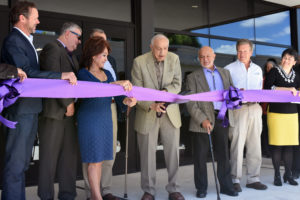
Margaret McKinney/Highlands University
Leveo Sánchez, chair of the Highlands Board of Regents, cuts the ribbon Sept. 12 for the historic Trolley Building, the new home for the Media Arts and Technology Department. Joining Sánchez from the left are Mark Baker, Baker Architecture + Design principal, Sam Minner, Highlands president, LouElla Marr-Montoya, Highlands regent, Frank Marchi, Highlands regent, Jim Franken, Franken Construction president and Sylvia Baca, Highlands interim facilities and planning director.
Las Vegas, N.M – Highlands University celebrated the transformation of a unique historic Las Vegas landmark into a state-of-the-art facility for its Media Arts and Technology Department at a ribbon cutting ceremony Sept. 12.
“A few years ago, this important historical building was in ruins, but the space called to many who saw it for what it could be,” said Highlands University President Sam Minner. “Today, we formally open this new space and it is a jewel in the crown of Highlands. It’s a place of high learning, creativity, engagement and beauty. The sleek and modern work done here by our media arts students is connected to the past in a powerful physical way in this building.”
Classes began in the 21,027-square-foot Trolley Building Aug. 17, the first day of fall semester.
Minner said that the media arts program at Highlands stands out as one of the strongest at the university, with a growing national and regional reputation.
“The media arts faculty are outstanding, students are very engaged in their learning and the professional standards in the program are among the highest on our campus. It is fitting that this incredible space is the new home for an incredible program,” Minner said.
He said the Trolley Building project was completed on time and on budget.
Media Arts and Technology Department chair Kerry Loewen said the Trolley Building architects, Baker Architecture + Design from Albuquerque, created an exceptional and innovative design.
“Lead architect Mark Baker and his team not only merged history and technology, but the design allows us to easily update our program and facility as times change. With this new facility, media arts can offer its students an exceptional learning environment and compete with any media arts program in the nation” Loewen said.
Loewen said the seed for the Trolley Building project was planted before he came to Highlands.
“In 2008, Miriam Langer, media arts professor and then department chair, envisioned the Trolley Building as a potential new home for media arts and has been a tireless advocate ever since. Miriam toured the building ruins with state historian Kak Slick and Mimi Roberts of the state Department of Cultural Affairs. The next day, Miriam created buttons promoting the Media Arts Trolley Building and started campaigning for what is now our new home,” Loewen said.
Sylvia Baca, interim facilities and planning director at Highlands, was the project manager and the university’s representative for the Trolley Building.
“I’d like to thank the outstanding team that took the concepts for the Trolley Building and made them into reality of bricks and mortar,” Baca said. “Baker Architecture + Design was committed to creating a unique, absolutely notable design, our construction manager Clay Simmons from Progressive Construction was an incredible help to me and kept the project on task, and Franken Construction, our general contractor, offered solid solutions throughout, especially Larry Franken the project superintendent. Phillip Martínez, Franken project manager, coordinated all the purchases from a spec book the size of the L.A. phone book.”
Some of the highlights of the Trolley Building include:
- 3-D printers and a large-scale laser cutter.
- Three classroom labs each equipped with 17 computer workstations with the latest design and multimedia software along with 79-inch monitors with ultra high-definition.
- A modern television studio for creating video with special effects.
- Labs for studio photography and audio mixing.
- An electronics maker space.
- An extensive equipment library that gives students access to the latest digital photography and video equipment.
- A soaring two-story studio for graduate student work and research projects.
- A gallery space in the lobby for student and community art exhibits.
The Trolley Building is a historic and architectural landmark built in the classic Romanesque style in 1905. It is on both the state and national historic registries. Every standing exterior wall and window was preserved in the building, which blends history with a modern industrial design.
Some of the architectural features include exposed sandstone walls and polished concrete floors inlaid with stainless steel rails to evoke the history of the trolley cars that rolled into the building. Original ironwork is exposed to add more historical flavor. A preserved steel barn door and large laser-cut historic map of Las Vegas grace the entrance.
The building is designed to meet Leadership in Energy and Environmental Design (LEED) Silver, a high-level measure of green building practices and sustainability. Examples include water-conserving fixtures, quality acoustic design and native landscaping.
“The building has skylights and its original picture windows that allow beautiful sunlight into the building, just one energy efficient measure of its design. Overall, it’s an exquisite building,” Baca said.
The total cost for the Trolley Building project was $8.3 million, which includes construction, media arts equipment, furnishings and professional services like architects, engineers and historical consultants.
Funding for the Trolley Building comes from state voter-approved $6 million in general obligation higher education bonds as well as a $2.3-million New Mexico legislative appropriation.
The Trolley Building is woven into the history of Las Vegas. Near the turn of the 20th century, Las Vegas was a bustling city that boasted one of only two electric trolley systems in the state. It operated until 1926, when the popularity of automobiles made it obsolete.
Recognizing its historical significance and close proximity to campus, Highlands purchased the trolley building in 1966 with an eye on future restoration.
